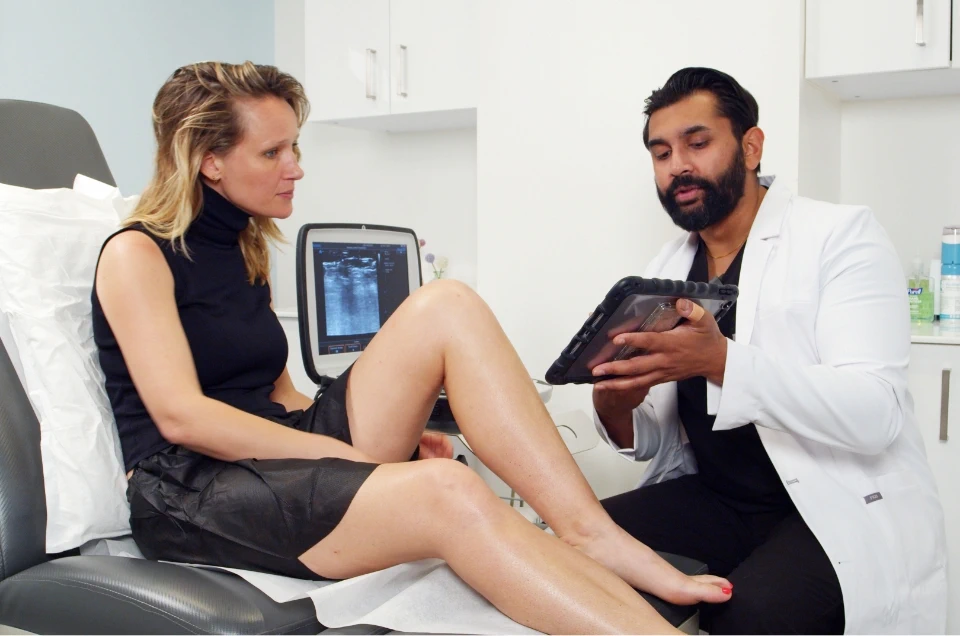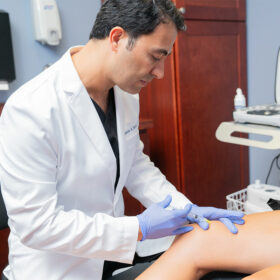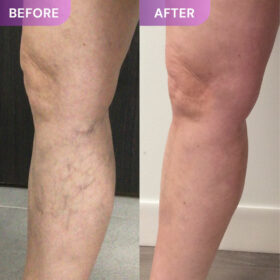At Vein Treatment Clinic, we strive to stay at the forefront of advancements in vein treatment technologies and techniques. In this guide, we explore the exciting developments shaping the future of vein treatment innovations. From minimally invasive vein treatments to cutting-edge technologies and telemedicine opportunities, let’s learn about the future of vein treatment.
Minimally Invasive Vein Treatments: The Gold Standard
Gone are the days when vein surgery was the go-to solution for varicose veins and spider veins. In the past, traditional surgical procedures often involved significant risks, prolonged downtime, and undesirable cosmetic outcomes. Historically, vein surgery typically required general anesthesia, large incisions, and lengthy recovery periods. Patients faced the risks of infection, scarring, and nerve damage, not to mention the discomfort associated with extended bed rest. Moreover, the cosmetic results of vein surgery were often less than satisfactory.
However, the landscape of vein treatment has undergone a remarkable transformation with the advent of minimally invasive vein treatments. At Vein Treatment Clinic, we recognize the limitations of traditional vein surgery and primarily offer minimally invasive treatments like endovenous laser ablation, sclerotherapy, VenaSeal, and more.
Advantages of Minimally Invasive Vein Treatments Over Surgery:
- Reduced Risk: Minimally invasive procedures carry a lower risk of complications compared to traditional surgery, including infection, bleeding, and nerve damage.
- Minimal Discomfort: Thanks to smaller incisions and targeted approaches, patients undergoing minimally invasive treatments experience less pain and discomfort.
- Faster Recovery: Minimally invasive techniques offer shorter recovery times, allowing patients to return to their normal activities sooner and minimizing disruption to daily life.
- Local Anesthesia: Many minimally invasive vein treatments can be performed under local anesthesia, eliminating the need for general anesthesia and its associated risks.
- Cosmetic Benefits: Minimally invasive procedures result in minimal scarring and better cosmetic outcomes compared to traditional surgery, enhancing patient confidence.
- Precise Targeting: Minimally invasive techniques allow vein specialists to precisely target diseased veins while minimizing damage to surrounding tissues.
- Outpatient Setting: Most minimally invasive vein treatments can be performed on an outpatient basis, reducing hospital stays and overall healthcare costs.
- Improved Venous Function: Minimally invasive procedures address underlying venous insufficiency, thus improving overall blood flow and reducing associated symptoms.
- Customized Treatment Plans: Minimally invasive vein treatments can be tailored to each patient’s specific needs and anatomy, optimizing overall outcomes.
- Long-Term Success: Minimally invasive techniques offer durable results, with lower rates of vein recurrence compared to traditional surgery, ensuring lasting relief from venous disorders.
Your Minimally Invasive Vein Treatment Options:
- Endovenous Laser Ablation (EVLA): Endovenous laser ablation, also known as laser vein treatment, is a minimally invasive procedure used to treat varicose veins and underlying venous insufficiency. During EVLA, a thin laser fiber is inserted into the diseased vein under ultrasound guidance. Once in position, the laser emits targeted energy, causing the vein to collapse and seal shut. Over time, the treated vein is naturally absorbed by the body, rerouting blood flow to healthier veins.
- Radiofrequency Ablation (RFA): Radiofrequency ablation is another minimally invasive technique for treating varicose veins and venous insufficiency. Similar to EVLA, RFA involves the insertion of a catheter into the diseased vein, guided by ultrasound imaging. The catheter delivers radiofrequency energy to the vein wall, heating it and causing it to collapse. Like EVLA, the closed vein is gradually absorbed by the body, restoring proper blood flow.
- VenaSeal: VenaSeal is a revolutionary vein closure system that utilizes medical adhesive to seal off diseased veins. During the procedure, a small amount of adhesive is injected directly into the targeted vein under ultrasound guidance. The adhesive bonds the vein walls together, effectively shutting down the vein. Unlike thermal ablation techniques, VenaSeal does not require tumescent anesthesia or heat energy, resulting in minimal discomfort and immediate return to normal activities.
- ClariVein: ClariVein is a minimally invasive treatment for varicose veins that combines mechanical agitation with sclerosant injection. A rotating wire is inserted into the diseased vein, delivering a sclerosant solution that irritates the vein walls and causes them to collapse. The rotating wire’s mechanical action enhances the distribution of the sclerosant, improving treatment efficacy. ClariVein is particularly suitable for treating veins that are difficult to access with traditional techniques.
- Ambulatory Phlebectomy: Ambulatory phlebectomy is a minimally invasive surgical technique for removing bulging varicose veins through tiny incisions. Unlike traditional vein stripping, which requires large surgical incisions, ambulatory phlebectomy involves making small punctures along the vein and extracting it piece by piece using special hooks or forceps. This approach minimizes scarring and discomfort while achieving excellent cosmetic results.
- Sclerotherapy: Sclerotherapy is a minimally invasive procedure for spider veins and small varicose veins. During the procedure, a sclerosant solution is injected directly into the affected veins, causing them to collapse and fade from view. Over time, the treated veins are absorbed by the body, resulting in smoother, clearer skin. Sclerotherapy is often performed as a standalone treatment or in conjunction with other vein procedures for comprehensive results.
Advancements in Imaging Technologies
The future of vein treatment lies in using advanced imaging technologies to precisely diagnose and treat venous disorders. Ultrasound imaging has long been a staple in vein clinics, providing real-time visualization of the venous system. However, newer imaging modalities, such as the Doppler ultrasound, offer enhanced detail and accuracy.
What Is Doppler Ultrasound?
Doppler ultrasound is a non-invasive imaging technique used to assess blood flow in the body’s blood vessels. It uses high-frequency sound waves to create real-time images of blood flow, allowing healthcare providers to evaluate the velocity and direction of blood flow within arteries and veins. Doppler ultrasound is particularly useful in diagnosing conditions such as deep vein thrombosis (DVT), peripheral artery disease (PAD), and venous insufficiency, providing valuable information for treatment planning and monitoring.
How Doppler Ultrasound Works
During a Doppler ultrasound, a handheld device called a transducer is placed against the skin overlying the blood vessel of interest. The transducer emits high-frequency sound waves that bounce off red blood cells as they move through the vessel. By measuring the frequency shift (Doppler effect) of the reflected sound waves, the ultrasound machine calculates the speed and direction of blood flow. This information is then displayed as a real-time visual representation on a monitor, allowing vein doctors to assess blood flow patterns and detect abnormalities.
We Use Doppler Ultrasound For:
- Diagnosing Venous Disorders: Doppler ultrasound enables us to accurately diagnose venous conditions such as deep vein thrombosis (DVT), chronic venous insufficiency (CVI), and superficial thrombophlebitis.
- Assessing Blood Flow: We use Doppler ultrasound to evaluate blood flow velocity, direction, and patency in veins, aiding in the diagnosis and monitoring of vascular diseases.
- Guiding Treatment Planning: Doppler ultrasound helps us determine the most appropriate minimally invasive spider vein or varicose vein treatments for each patient.
- Monitoring Treatment Outcomes: We utilize Doppler ultrasound to assess the effectiveness of vein treatments over time, ensuring optimal results and patient satisfaction.
- Identifying Venous Anatomy: Doppler ultrasound provides detailed images of the venous anatomy, allowing us to identify anatomical variations and tailor treatment plans.
- Guiding Venous Interventions: During minimally invasive vein procedures such as endovenous laser ablation (EVLA) and sclerotherapy, Doppler ultrasound helps guide the placement of catheters and monitor treatment progress in real time.
- Ensuring Patient Comfort: Doppler ultrasound is non-invasive, painless, and radiation-free, ensuring a comfortable and safe experience for our patients during diagnostic tests.
Telemedicine and Remote Monitoring
The integration of telemedicine and remote monitoring technologies has revolutionized the delivery of vein care, making it more accessible and convenient for patients. Teleconsultations allow patients to consult with vein specialists from the comfort of their homes, eliminating the need for travel and reducing wait times. Remote monitoring devices, such as wearable sensors and smartphone apps, enable patients to track their vein health and communicate information to their healthcare providers in real time. This approach to monitoring allows for early intervention and timely adjustments to treatment plans, optimizing outcomes and patient experience.
Contact Vein Treatment Clinic for Cutting-Edge Vein Treatments
As we look ahead to the future of vein treatment, the possibilities are exciting and promising. From minimally invasive procedures and advanced imaging technologies to telemedicine, the field of vein care is undergoing rapid evolution. At Vein Treatment Clinic, we remain committed to staying at the forefront of these advancements, ensuring that our patients receive the highest standard of care. Whether you’re seeking relief from varicose veins or spider veins, you can trust us to provide innovative solutions — schedule a consultation today.












